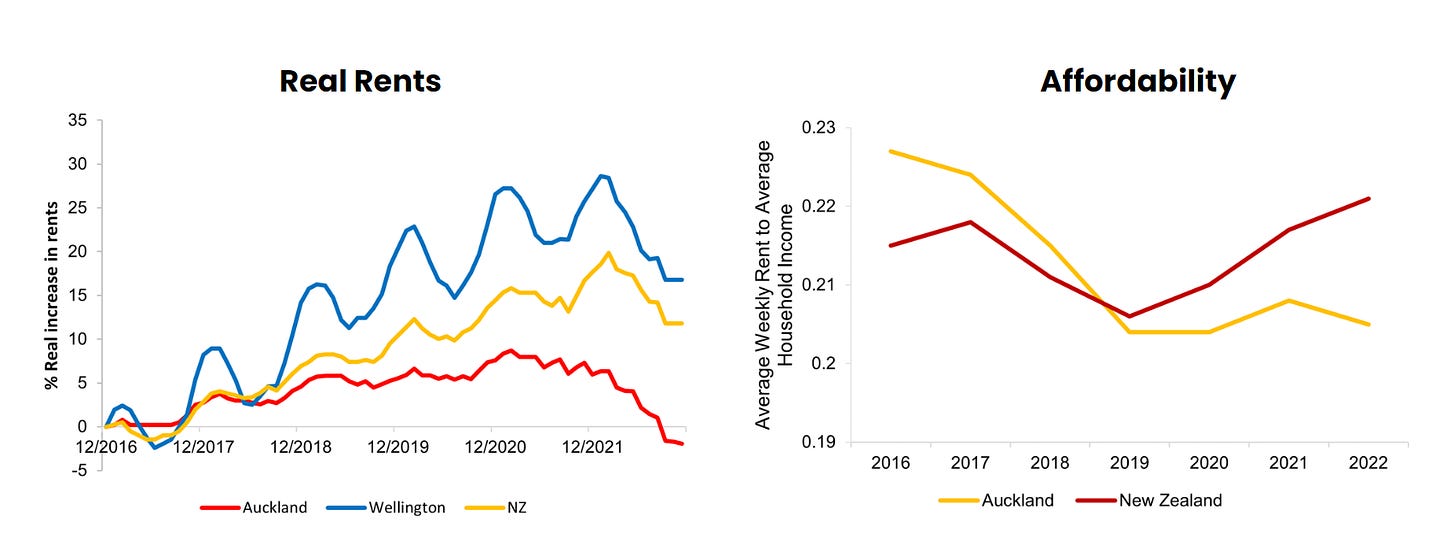Auckland: the 2016 upzoning worked
More construction, expanding total supply by 4%; lower rents

In 2016 Auckland upzoned about 75% of its core urban area. Six years later, there’s been a lot more construction, expanding total housing supply by 4%. Rents in Auckland haven’t risen as fast as in the rest of New Zealand, and affordability (rent as a percentage of household income) is now better than in the rest of the country, when it used to be worse.
Summary of zoning restrictions following the upzoning, from a paper by Ryan Greenaway-McGrevy and Peter Phillips. The “Single House Zone” restrictions are basically the starting point.
An article by Greenaway-McGrevy describing the reform and its impacts, from January 2022:
In 2016, the nation’s largest city, Auckland, upzoned approximately three-quarters of its residential land area under the Auckland Unitary Plan (AUP). Auckland houses about a third of the nation’s 5 million people, and is also the country’s commercial capital, accounting for 38% of the gross domestic product.
Although motivated by a variety of factors, the undersupply of housing and erosion of housing affordability were the prominent justifications for the zoning reforms introduced under the AUP. The municipal government for the entire metropolitan area, the Auckland Council, estimated that the plan tripled the dwelling capacity of the city.
My work with Peter Phillips shows that the AUP has enabled a construction boom. New housing units permitted have increased every year since the policy was enacted, with all of these increases occurring in the city’s upzoned areas.
Matthew Maltman describes how rents in Auckland have grown more slowly than in the rest of New Zealand:
In 2010, Auckland was the most expensive major city in New Zealand to rent in, with renters having to pay a ‘premium’ to rent there relative to other cities. Since the upzoning reforms, rents in Auckland have grown more slowly than the national average, as well as Wellington (another large major city for comparison): it is now cheaper, on average, to rent in Auckland than in Wellington. Lower-quartile rents have actually grown more slowly in Auckland than median rents. From 2010 to the end of 2016, lower-quartile rents grew by around 38 per cent. From 2016 until today, these rents only grew by 13 per cent.
And, these comparisons above may underestimate the real effect of upzoning on Auckland rents. All else being equal, lower rents in Auckland encourage more people to move there from other cities, shifting demand to Auckland and away from other cities. Landlords in other regions in New Zealand may have to lower their prices to compete.
Links:
One Final Effort: Auckland, by Matthew Maltman. Explains the 2016 reform and its impacts on home construction and on rents.
New Zealand’s bipartisan housing reforms offer a model to other countries, by Ryan Greenaway-McGrevy, from January 2022. Explains both the 2016 reform in Auckland and the more recent New Zealand reforms at the national level.
Future of Auckland unveiled: Unitary Plan to go up and out. By Bernard Orsman and Simon Collins in the New Zealand Herald, July 2016.
Auckland Council's Unitary Plan passed. By Bernard Orsman, August 2016.
The Impact of Upzoning on Housing Construction in Auckland, 2021 paper by Greenaway-McGrevy and Phillips.
The effect of upzoning on house prices and redevelopment premiums in Auckland, New Zealand. 2021 paper by Greenaway-McGrevy, Gail Pacheco, and Kade Sorensen. Comparing upzoned areas to non-upzoned areas, they found that upzoning increased the prices of moderate or low-density housing (e.g. a lot with a single-family house), but decreased the prices of high-density housing.


